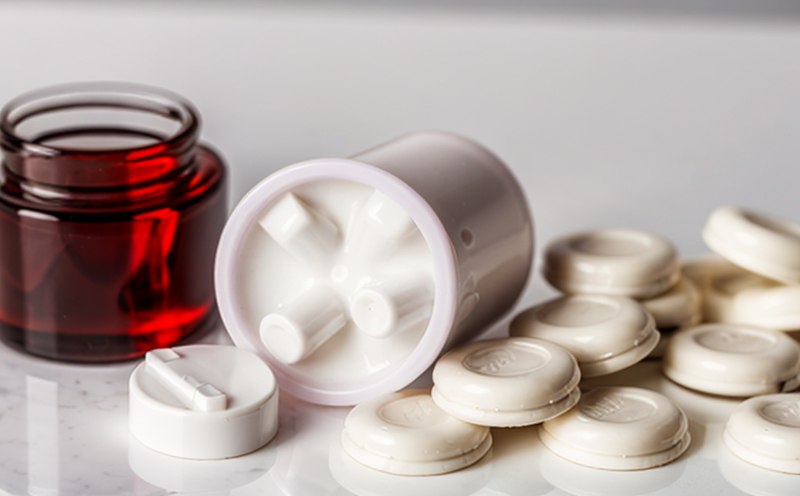USP Content Uniformity Testing of Capsules
The USP (United States Pharmacopeia) Content Uniformity Test is a critical quality control measure used to ensure that each individual unit of an oral solid dosage form, such as capsules, contains the same amount and type of active ingredient. This test is essential in pharmaceutical manufacturing because it ensures that medications are consistent across all units produced, thereby maintaining therapeutic efficacy and patient safety.
The USP Content Uniformity Test requires a precise method to ensure accuracy. Samples from multiple locations within the capsule are extracted and analyzed for their content of the active drug substance. The test involves dissolving the capsules in a suitable solvent, filtering the solution, and measuring its absorbance or other relevant parameters using spectroscopic techniques.
The process begins with proper sampling of the capsules. This is critical as the variability within the sample can significantly affect the results. Once sampled, the contents are dissolved and filtered through a membrane filter to remove any insoluble particles before measurement. The solution is then analyzed for its absorbance or other relevant parameter using UV-Vis spectrophotometry.
The USP guidelines provide specific criteria for this test. A standard deviation of no more than 15% from the average content of the individual units is required to pass the test. If the standard deviation exceeds this limit, further investigation into the manufacturing process and quality control measures are necessary.
In practice, laboratories equipped with advanced instrumentation such as UV-Vis spectrophotometers or HPLC (High Performance Liquid Chromatography) can perform these tests efficiently. The use of automated systems for dissolution and filtration ensures precision and consistency in sample preparation. Advanced software tools help in data analysis and reporting.
The importance of this test cannot be overstated, especially when considering the health and safety of patients relying on medication. Ensuring content uniformity is not only a regulatory requirement but also a commitment to quality and patient well-being.
Benefits
The USP Content Uniformity Test offers several significant benefits in pharmaceutical manufacturing:
- Enhanced Patient Safety: Ensuring that each capsule contains the same amount of active ingredient reduces variability, leading to more predictable and consistent therapeutic outcomes.
- Regulatory Compliance: Adherence to USP standards ensures that products meet regulatory requirements and can be marketed legally.
- Improved Product Quality: The test helps identify and address manufacturing issues early in the process, thereby improving overall product quality.
- Cost Efficiency: Early detection of inconsistencies allows for corrective actions to be taken promptly, reducing waste and rework costs.
In summary, USP Content Uniformity Testing is a cornerstone of pharmaceutical quality assurance. By ensuring consistent content within each capsule, it plays a vital role in maintaining product integrity and patient safety.
Industry Applications
| Industry Segment | Application |
|---|---|
| Pharmaceutical Manufacturing | Ensuring content uniformity in capsule production. |
| Diagnostics and Biotechnology | Quality control of diagnostic reagents. |
| Consumer Health Products | Maintaining consistent efficacy across product lines. |
| Agriculture | Consistency in active ingredient content for effective pest and disease management. |
| Bioavailability Studies | Assessing the effectiveness of drug delivery systems. |
The USP Content Uniformity Test is widely used across various industries, ensuring that products meet stringent quality standards. Its application in pharmaceutical manufacturing ensures that patients receive consistent and effective medication.
Competitive Advantage and Market Impact
The USP Content Uniformity Test provides a competitive advantage by ensuring superior product quality, which can lead to increased customer satisfaction and loyalty. This test is not only a regulatory requirement but also an essential component of a company's commitment to excellence.
Companies that invest in robust testing methodologies like this are better positioned to meet market demand and maintain compliance with international standards such as USP, ISO, and ICH (International Conference on Harmonisation). By adhering to these standards, pharmaceutical companies can ensure that their products are safe, effective, and of high quality.
Moreover, consistent product quality enhances brand reputation and trust among consumers. This is particularly important in the highly competitive pharmaceutical market where patient safety and efficacy are paramount. Companies that prioritize such tests demonstrate a strong commitment to quality, which can translate into long-term success and growth.





